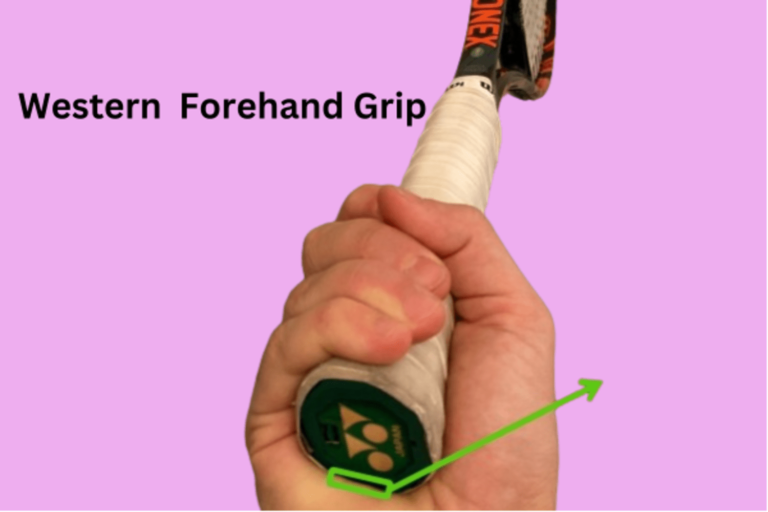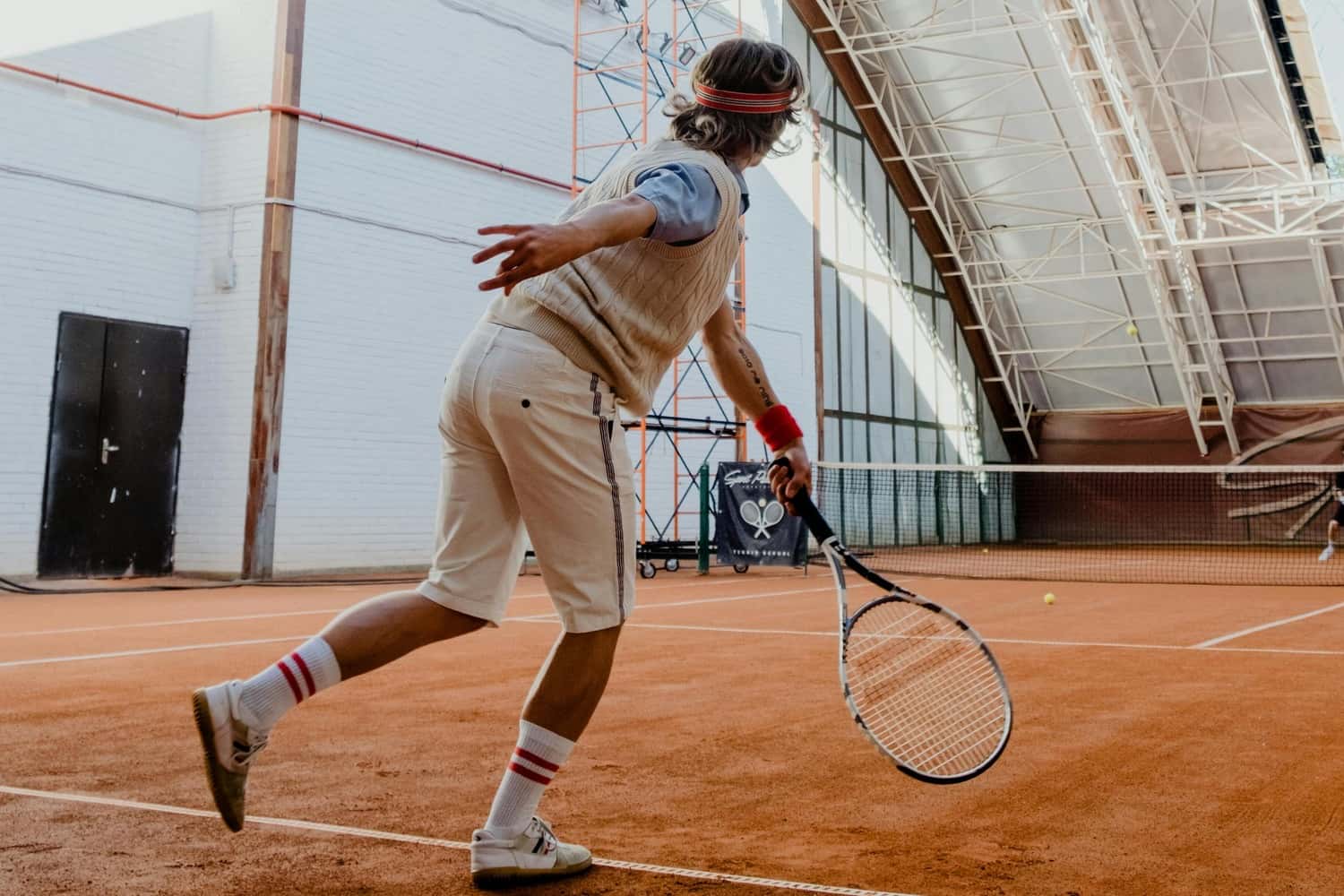The Forehand Tennis grip is a way to hold your racket to hit a forehand shot. It is a stroke where you swing the racket across your body from the dominant side. It is common as the forehand tennis grip. Forehand Tennis Grip comes in a variety of forms, each with pros and cons of its own. Eastern, Western, Continental and Semi-Western are the types of Forehand Tennis Grip.
Are you a beginner or have an interest in Forehand Tennis Grip? So you can find out all about Forehand Grips. At the end of this blog post, you will able to differentiate all types of Forehand Grips. You will read all the crucial information about Tennis Grips. Let’s proceed towards our recent topic.
Your playing style, and skill level, will determine which forehand grip is ideal for you. You can try out various grips to see which one is most efficient and comfortable for you. With the neutral grip of the Eastern forehand, you may strike flat or topspin with ease. The greatest topspin and angle produced with Western Forehand. This extreme grip, also demands greater timing and accuracy. Continental is an old type of grips. It is difficult to hit topspin and handle high balls with a continental grip.
Table of Contents
ToggleTypes of Forehand Tennis Grip
The types of Forehand Tennis Grip are as follows:
- Continental Forehand Grip
- Semi-Western Forehand Grip
- Western Forehand Grip
- Easter Forehand Grip
- One Handed Forehand Grip
- Two-Handed Forehand Grip
Continental Forehand Tennis Grip

A form of grip used for serves, volleys, slices, and overheads, is the continental grip. Because it mimics how a hammer holds, it is also known as the hammer grip. If you are right-handed, place the palm-side knuckle of the index finger on the handle’s bevel 2. If you are lefty, you should place it on the bevel 8.
It is an old-fashioned forehand grip which rarely used today. We call it “the Shotgun” grip. This is a result of its peculiar assault strategy and ball pressure. The grip is always positioned close to the racket shaft for the largest impact. So, the racket will hit the ball hard, much to a shotgun. Shotgun is the name of a result.
Advantages
- It is simple to learn and transition between different grips. Since there is little hand rotation or change needed.
- The flat or open racket face helps players smash the ball. That makes it useful for striking lowballs and quick courts.
- It allows players to hit the ball with a full swing and incorporate their body weight into their shots. So it is beneficial for producing power and accuracy.
Disadvantages
- Topspin and net clearing are difficult because they need a more horizontal motion
- High balls with strong spin need players to strike the ball above shoulder level. So it is difficult to control.
How can form a Continental Forehand Tennis Grip?
- If you are lefty, place bevel 2 on the palm side of the bottom knuckle of your index finger.
- If you are right-handed, set it to bevel 8 to produce the continental grip.
- Place the butt of the racket handle at the base of your palm next.
Semi-Western Forehand Tennis Grip
With this more modern grip, your forehand will produce more force and topspin. Turn your hand from the eastern grip in a clockwise direction (for right-handers). Or counterclockwise direction (for left-handers) until the index finger is on the next bevel.
With this grip, greater topspin is possible because the racket face is close upon contact. It enables fast grip modifications and excellent topspin. Positioned between the eastern and western grips is the semi-western grip. In modern tennis, it has emerged as the most used forehand grip.
In the 1990s and the beginning of the 2000s, Martina Hingis and Andre Agassi employed this grip. But, Serena Williams and Novak Djokovic use this in the present era.
Advantages
- Exceptional topspin
- Quick grip shifts
- Ideal for baseline and all-court play
- Outstanding defense against balls with higher bounce
- Efficient across all court surfaces
Disadvantages
- Difficult with low balls
How can form a Semi-Western forehand grip?
- Put the palm side of your index bottom knuckle against the bevel 4 if you are right-handed
- Position it against the bevel 6, for left-handers to create a semi-western grip
- Next, position the racket handle at your palm’s base
Western Forehand Tennis Grip
Western Forehand Tennis Grip can produce a lot of topspin and force on the forehand side. Baseline players who want to hit high over the net and produce strokes have success with this grip. But it also has disadvantages, like making low balls difficult and flattening shots.
The Western Forehand Tennis Grip is one of the extreme grips used to create topspin. It allows players to generate good topspin, taking it a step farther than the semi-western. The knuckle is on the Semi-Western bevel 4, and the heel is on the Western side.
The Western grip is popular among players from Europe and Latin America, with a lot of clay courts. Many players on the professional tour also use it. The slowest court surface is clay, where the ball bounces higher. Severe grips emphasize this increased topspin and bounce.
A few pros on the tour use it, but many find it a little too harsh. At the most basic level, it is difficult to strike a forehand with this grip.
Features of Western Forehand Tennis Grip

- The racket head is very closed and the swing is more circular.
- They permit more topspin and power on the forehand side.
- Topspin facilitates the ball’s descent into the court. It allows for more forceful shots over the net.
- The contact point is in front of the body and close to chest level, they are perfect for handling high balls.
- The low racket head and quick swing, are challenging to use for low balls, flat shots, and grip adjustments.
- The motion needs to be quite vigorous to generate power, they might put stress on the wrist and forearm.
Advantages
Extreme topspin
Players can smash the ball with an upward motion and a high degree of topspin by using it. This causes the ball to bounce higher and more difficult for the opposition to control.
Strong shots
Players can twist the racket and transfer their body weight into their swings by using it. Then it produces strong winners. Players may hit with a complete swing and keep the ball in the court with this grip.
High control and accuracy
The western grip makes it easier to change the racket face’s angle and direction. Players can control and make more accurate shots. The topspin aids in the ball’s inward descent and outward curvature.
Disadvantages
- Difficult to fast switch grips
- Difficult for beginners to learn
- Low shots that are challenging to control and need players to move outside of their strike zone
How can form a Western forehand grip?
- Regardless of your hand orientation, match the index knuckle’s palm side with bevel 5. The handle’s midway point, to establish the western grip.
- Next, position the racket handle at your palm’s base.
- Then put your fingers around it.
Eastern Forehand Tennis Grip
Tennis players who use the eastern grip can hit flatter and more aggressive shots. But they can also produce less topspin and net clearing. The Eastern forehand grip is often used for flatter groundstrokes. Position the heel pad and index knuckle on the bevel-3 to execute an Eastern Forehand Grip.
It is easy to use this strategy to get an Eastern forehand. Grip the handle by sliding down to it and placing your palm flat against the strings. As hard courts replaced grass courts in the Eastern US, their use increased. Because the firm surface caused the balls to bounce higher. Juan Martin Del Potro and Roger Federer used the Eastern forehand grip.
Features of Eastern forehand grip
- Due to less hand rotation or change, it is simple to learn and operate.
- It enables players to hit the ball with an open racket face. It is helpful for lowballs and quick courts.
- Players may smash the ball with a complete swing and transfer their body weight into their shots. Hence it improves their power and accuracy.
- Topspin and net clearing are difficult because they need more horizontal motion.
- Balls with strong spin need above shoulder level, it is difficult to control.
- To gain further knowledge about the eastern
Advantages
- Quick grip changes, ideal for serving and volleying, sufficient topspin production
- Good performance on faster court surfaces
- Easier for novices to comprehend
Disadvantages
- In contrast to counterparts in the West, less topspin
- Having problems managing balls with higher bounce
- Not ideal for confident baseline play
One Handed Forehand Grip
It is a way to hold a racket with your dominant hand while hitting shots. On the forehand side, it permits greater reach, angle, power, and diversity. But it also calls for greater strength, timing, and accuracy. Forehand topspin and arc can increase with this grip, beneficial in today’s tennis.
Players that compete in the ATP and WTA Tours still use one-handed topspin. More players are employing it on the men’s side to compete in the biggest game. Roger Federer, Dominic Thiem, Stan Wawrinka, and Grigor Dimitrov all use it. Promising players including Denis Shapovalov and Stefanos Tsitsipas also favor one-handed play.
Currently, five of the top twenty men’s players use the one-handed backhand. But, not a single player among the top 50 female players makes use of it.
A player starts two-handed when their coordination and skill level are poor.

Advantages
- High control
Disadvantages
- In most cases, the steep learning curve
- Requires power and coordination.
- Obtaining a second serve is difficult.
- Higher balls are difficult to control.
- Adopt a difficult, broad stance.
Two-Handed Forehand Grips
It is a way of holding the racket with both your dominant and non-dominant hand. It provides greater forehand stability, control, and consistency. It also restricts reach, angle, power, and diversity. Combining the eastern forehand grip for the non-dominant is often used. The continental grip for the dominant hand results in a two-handed forehand grip.
Because it combines power and spin on the forehand, this is a strong forehand. Monica Seles, who possessed this forehand in women’s tennis history, popularized it.

Advantages
- Increased control and stability on the front side
- Increased precision and uniformity
- Higher balls are easier to manage
- The following are some drawbacks of a two-handed forehand grip
- reduced forehand side reach and angle
- Reduced strength and possibility for spin Less diversity and adaptability
Disadvantages
- Needs more strength and coordination
Conclusion
In conclusion, the Forehand Tennis Grip is brilliant for high topspin and strokes. way to hold your racket to hit a forehand shot. It is a stroke where you swing the racket across your body from the dominant side. Your playing style, and skill level, will determine which grip is ideal for you. Forehand Tennis Grip helps to guide many beginners and advanced players.
A form of grip used for serves, volleys, slices, and overheads, is the continental grip. Its position is like a hammer, so known as a hammer. Western forehand grip can produce a lot of topspin and force on the forehand side. Tennis players who use the eastern grip can hit flatter and more aggressive shots. You can form a one-handed forehand grip with your dominant hand. And two-handed with both dominant and nondominant hands.

